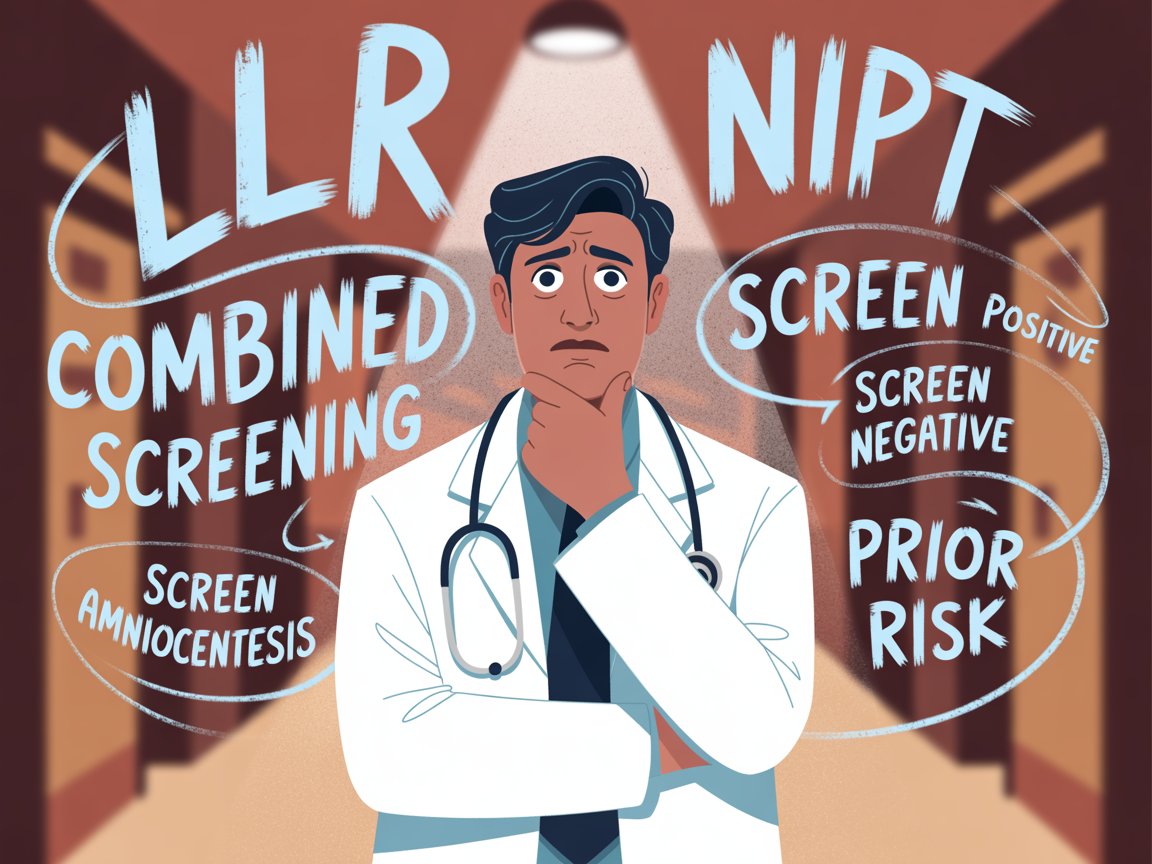Understanding how prenatal risk for aneuploidies (especially Trisomy 21) is calculated is crucial for proper interpretation and counseling. This article walks through the stepwise risk estimation process, starting from maternal age, incorporating first-trimester combined screening, ultrasound soft markers, and finally, non-invasive prenatal testing (NIPT). It’s backed with formulas and real clinical examples.
A Priori Risk
A priori risk is the baseline probability of a fetus having aneuploidy based on maternal age alone. For example:
| Maternal Age | A Priori Risk of T21 |
|---|---|
| 25 years | 1 in 1200 |
| 32 years | 1 in 850 |
| 39 years | 1 in 100 |
This risk serves as the starting point for further adjustments after screening. Not all prior risks will change with the maternal age as in Turner Syndrome.
Combined First Trimester Screening
The combined test refines the age-based risk by using:
- NT (nuchal translucency)
- Serum biochemistry: free β-hCG and PAPP-A
- Nasal bone, Ductus venosus flow, and presence of Tricuspid regurgitation
The result is an adjusted (posterior) risk using Bayes’ theorem:
Posterior Odds = Prior Odds × Likelihood Ratio
Posterior Risk= Posterior Odds / (1+Posterior Odds)
Example:
A 35-year-old woman has an age risk of 1 in 350. Her combined test results yield an adjusted risk of 1 in 150 due to increased NT and low PAPP-A. This is now a screen-positive result (cut-off = 1 in 250).
Role of NIPT: Adding Precision
NIPT offers superior sensitivity and specificity. Its result can be integrated into risk calculation using likelihood ratios or log likelihood ratios (LLRs).
Formulas:
- Positive LR (LR⁺):
LR+= Sensitivity/ (1−Specificity)
- Negative LR (LR⁻):
LR−= (1−Sensitivity)/Specificity
Typical for T21:
- Sensitivity ≈ 99.5%
- Specificity ≈ 99.9%
- LR⁺ ≈ 995
- LR⁻ ≈ 0.005
In Indian settings, NIPT is usually done if the combined screen is positive for aneuploidies (risk of 1/250 or more).
Case: Risk after combined screening is 1 in 80, NIPT Negative
- Prior odds = 1/79
- LR⁻ of NIPT = 0.005
- Posterior odds = 1/79 × 0.005 ≈ 0.000063
- Posterior risk = ~1 in 15,800
This means that after doing the NIPT for a screen-positive lady in combined screening, the risk has reduced to 1 in 15,800. NIPT has a strong negative predictive value.
Case: Risk after combined screening is 1 in 80, NIPT Positive
- Prior odds = 1/79
- LR⁺ of NIPT = 995
- Posterior odds ≈ 12.6
- Posterior risk = ~92.6%
The risk is high now, and hence we need to confirm with invasive testing (amniocentesis or chorionic villus sampling).
Case: NIPT LLR = 5 (i.e., log(LR⁺) = 5)
These days, the labs usually give the Log Likelihood Ratio (LLR) along with the NIPT report. It is important to know how to interpret LLR.
- LLR stands for Log Likelihood Ratio. To know more, do read our article on the same.
- If LLR is 5, Likelihood Ratio (LR) = 105 = 100,000
- Prior odds = 1/79
- Posterior Odds = Prior Odds×LR = 10,000 x 1/79 = 1265
- Posterior risk = Posterior Odds/ (1+ Posterior Odds) = 99.9%
Strong positive, but still not diagnostic. We need to confirm it with amniocentesis.
What If NIPT LLR = 3 or –1 in a case with a combined risk of 1/250?
If LLR = 3 (Positive screen)
- LR = 10³ = 1000
- Prior odds = 1/249
- Posterior odds = 1000/249 = 4.016
- Posterior risk = 4.016 / (1 + 4.016) ≈ 80.1%
If LLR = –1 (Negative screen)
- LR = 10⁻¹ = 0.1
- Posterior odds = 1/249 × 0.1 = 0.000401
- Posterior risk ≈ 1 in 2491
Do I Need to Offer NIPT When Combined Risk is 1 in 1000?
Yes, optionally.
For example, a 39-year-old has an age risk of 1 in 100 but a combined screen risk of 1 in 1000.
Despite the negative screen, her age-based biological risk remains high, making NIPT a useful next step for added reassurance.NIPT can be advised for a lady who previously had a child with aneuploidy.
Do Combined Screen Results Matter If Age Risk Is Lower?
Absolutely yes.
Combined screen modifies the age risk.
Example:
- A 28-year-old (age risk 1/1200) gets screen-positive at 1/150 → take action
Always act based on the adjusted (posterior) risk, not age alone.
What Does a Report Showing Age Risk 1/170 and Combined Risk 1/1000 Mean?
This means:
- Baseline age risk was high
- Markers were favorable, reducing risk significantly
- Final adjusted risk = 1 in 1000 → screen-negative
However, as the age risk is higher than the risk that is considered screen positive (1/250), the option of NIPT needs to be given.
How to Use Soft Markers and Combine Their LR
Soft markers seen on ultrasound modify risk via likelihood ratios.
| Marker | T21 LR⁺ | T21 LR⁻ |
|---|---|---|
| Absent nasal bone | 6.6 – 23 | ~0.4 |
| Echogenic bowel | 1.65 – 8 | 0.9 |
| Short humerus | 5.1 – 7.5 | ~0.8 |
| EICF | 0.9 – 1.8 | ~0.95 |
| Choroid plexus cyst (CPC) | 1-5.6 for T18 (Not T21) | ~1 |
Combining LRs of Multiple Soft Markers:
Case Example: Adjusting Trisomy 21 Risk Using Multiple Soft Markers (Present and Absent)
Clinical Context:
A 32-year-old woman underwent first-trimester combined screening.
- Combined screen risk for Trisomy 21 = 1 in 900 (screen-negative)
- In the second-trimester anomaly scan, the following soft markers are noted:
- ✅ Short humerus – Present → LR⁺ = 7.5
- ✅ Echogenic bowel – Present → LR⁺ = 8
- ❌ Nasal bone – Present (i.e., not absent) → LR⁻ = 0.4
- ❌ EIF – Absent → LR⁻ = 0.95
- ❌ Choroid plexus cyst (CPC) – Absent → LR⁻ = 1.0
We now integrate all these findings to recalculate the individualized risk.
Step-by-Step Risk Adjustment Using Bayes’ Theorem
1. Combine Likelihood Ratios
Use:
- LR⁺ for markers that are present
- LR⁻ for markers that are absent
Combined LR= (7.5×8)×(0.4×0.95×1.0) = 60×0.38= 22.8
2. Convert Combined Screen Risk to Prior Odds
Prior risk=1900, Prior odds=1/ 899
3. Multiply Prior Odds by Combined LR
Posterior odds = 1899×22.8 ≈ 0.02537
4. Convert Odds to Risk
Posterior risk = 0.025371/ (1+0.02537) ≈0.02474= 2.47%
Converting 2.47%, the final risk is 1/40
Clinical Interpretation:
Despite an initially reassuring combined screen risk of 1 in 900, the presence of two high-risk soft markers (short humerus and echogenic bowel) caused a 24-fold increase in odds.
The presence of reassuring features (nasal bone, absence of EIF and CPC) helped reduce the effect, but not enough to bring the risk back to the screen-negative zone.
Final adjusted risk is 1 in 40, now screen-positive.
Clinical Takeaway:
- Always use LR⁺ for present markers and LR⁻ for absent markers together.
- Multiply all LRs to calculate a combined LR.
- Use Bayes’ theorem to refine prior odds into individualized posterior risk.
Offer:
- NIPT for high-resolution, non-invasive screening
- Or proceed to invasive testing (amniocentesis) if definitive diagnosis is preferred
Conclusion
Prenatal aneuploidy risk assessment is a dynamic process, integrating:
- Maternal age for baseline risk
- First-trimester markers to refine risk
- Soft markers (present or absent) to adjust further
- NIPT, the most sensitive screen, to push the risk to near-diagnostic levels



One response
Amazing . Give me some credits too 😜